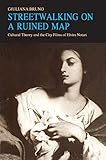Streetwalking on a Ruined Map : Cultural Theory and the City Films of Elvira Notari / Giuliana Bruno.
Material type: TextPublisher: Princeton, NJ : Princeton University Press, [2021]Copyright date: ©1993Description: 1 online resource (436 p.)Content type:
TextPublisher: Princeton, NJ : Princeton University Press, [2021]Copyright date: ©1993Description: 1 online resource (436 p.)Content type: - 9781400843985
- City and town life in motion pictures
- Motion pictures for women -- Italy
- Motion pictures -- Italy -- History
- Women in motion pictures
- PERFORMING ARTS / Film & Video / History & Criticism
- Accattone (film)
- Aleramo, Sibilla
- Amoroso, Roberto
- Antonioni, Michelangelo
- Artaud, Antonin
- Artemisia (book)
- Automartirio (film)
- Bataille, Georges
- Bebè vi saluta (film)
- Bernini, Gianlorenzo
- Bovi, Michele
- Caesar Productions
- Cangiullo, Francesco
- Crary, Jonathan
- Cuore (book)
- Daisy Film
- Dalbono, Edoardo
- De Sica, Vittorio
- Doane, Mary Ann
- Eakins, Thomas
- Eisenstein, Sergei
- Esposito, Pasquale
- Farassino, Alberto
- Ferrigno, Antonio
- Flaubert, Gustave
- Freud, Sigmund
- Gall, Franz Joseph
- Gentili, Hester
- Gnesella (film)
- Hansen, Miriam
- Hawks and Sparrows (film)
- I vermi (novel)
- Illuminati, Ivo
- Irigaray, Luce
- Joli, Antonio
- Karenne Film
- Kleine, George
- Kuhn, Annette
- Lacan, Jacques
- Le Brun, Charles
- Le ombre (novel)
- Lombardo, Gustavo
- Mancini, Antonio
- Napoli nel cinema (book)
- Nepoti, Alberto
- Notari, Maria
- Notari, Olga
- Open City (film)
- Paolella, Roberto
- Pubblica Sicurezza
- Raggio, Elettra
- cinematografeide (film epidemics)
- compilation film
- deviant personalities
- 791.43 023 092 20
- PN1998.3.N68
- online - DeGruyter
| Item type | Current library | Call number | URL | Status | Notes | Barcode | |
|---|---|---|---|---|---|---|---|
 eBook
eBook
|
Biblioteca "Angelicum" Pont. Univ. S.Tommaso d'Aquino Nuvola online | online - DeGruyter (Browse shelf(Opens below)) | Online access | Not for loan (Accesso limitato) | Accesso per gli utenti autorizzati / Access for authorized users | (dgr)9781400843985 |
Frontmatter -- Contents -- Acknowledgments -- Mapping Out Discourse: An Introduction -- PART I. SUPPRESSED KNOWLEDGE OF ELVIRA CODA NOTARI AND NEAPOLITAN FILM: A HISTORICAL PANORAMA -- 1. Questions of History and Film in Italian Culture -- 2. Film Journals and Film Historiography -- PART II. FILM IN THE CITYSCAPE: A TOPOANALYSIS OF SPECTATORSHIP -- 3. Streetwalking around Plato's Cave, or The Unconscious Is Housed -- 4. Spectatorial Embodiments: Anatomies of the Visible and the Female Bodyscape -- PART III. MANUFACTURING FILM CULTURE -- 5. Dora Film: An Urban Production House -- 6. Women at Work: Manufacturing Movies -- 7. Dora Film of America: Women and Immigrants in the American Dream -- 8. Censorship: A Cuton the Wings of Desire -- PART IV. THE METROPOLITAN TEXTURE -- 9. Fragments o f an Analyst's Discourse: Lacunae -- 10. The Architecture of Public Melodrama: A Corporeality of the Street -- 11. Between the Feast and the Law: The Carnivalization of Narration -- 12. City Views: Filmic Cityscape, Artistic Perspective, and Touristic Travel -- PART V. FEMALE GEOGRAPHIES -- 13. Anatomy of an Analysis: The Authorial Noir -- 14. Popular Cinema and Women's Literature: The Transito of Female Discourse -- 15. Medical Figures: Hysteria and the Anatomy Lesson -- 16. Topographies of Dark Female Pleasures -- 17. Written on the Body: Eroticism, Death, and Hagiography -- Notes -- Filmography -- List of Illustrations -- Index
restricted access online access with authorization star
http://purl.org/coar/access_right/c_16ec
Emphasizing the importance of cultural theory for film history, Giuliana Bruno enriches our understanding of early Italian film as she guides us on a series of "inferential walks" through Italian culture in the first decades of this century. This innovative approach---the interweaving of examples of cinema with architecture, art history, medical discourse, photography, and literature--addresses the challenge posed by feminism to film study while calling attention to marginalized artists. An object of this critical remapping is Elvira Notari (1875-1946), Italy's first and most prolific woman filmmaker, whose documentary-style work on street life in Naples, a forerunner of neorealism, was popularly acclaimed in Italy and the United States until its suppression during the Fascist regime. Since only fragments of Notari's films exist today, Bruno illuminates the filmmaker's contributions to early Italian cinematography by evoking the cultural terrain in which she operated. What emerges is an intertextual montage of urban film culture highlighting a woman's view on love, violence, poverty, desire, and death. This panorama ranges from the city's exteriors to the body's interiors. Reclaiming an alternative history of women's filmmaking and reception, Bruno draws a cultural history that persuasively argues for a spatial, corporal interpretation of film language.
Mode of access: Internet via World Wide Web.
In English.
Description based on online resource; title from PDF title page (publisher's Web site, viewed 30. Aug 2021)


